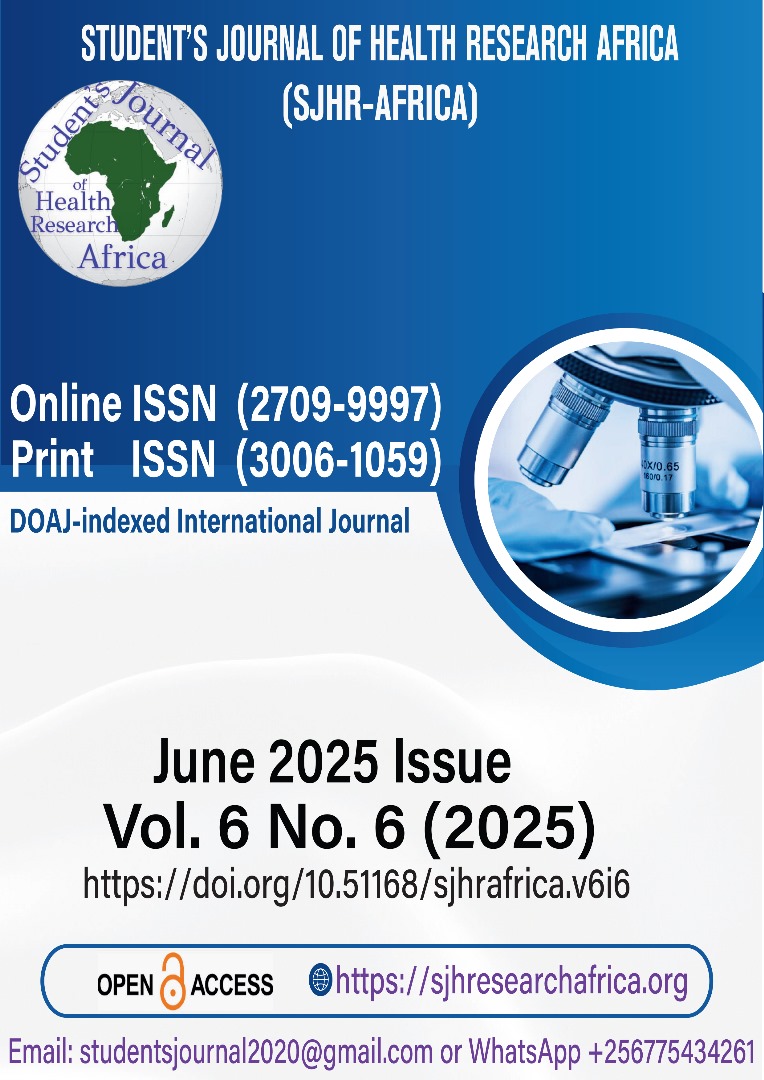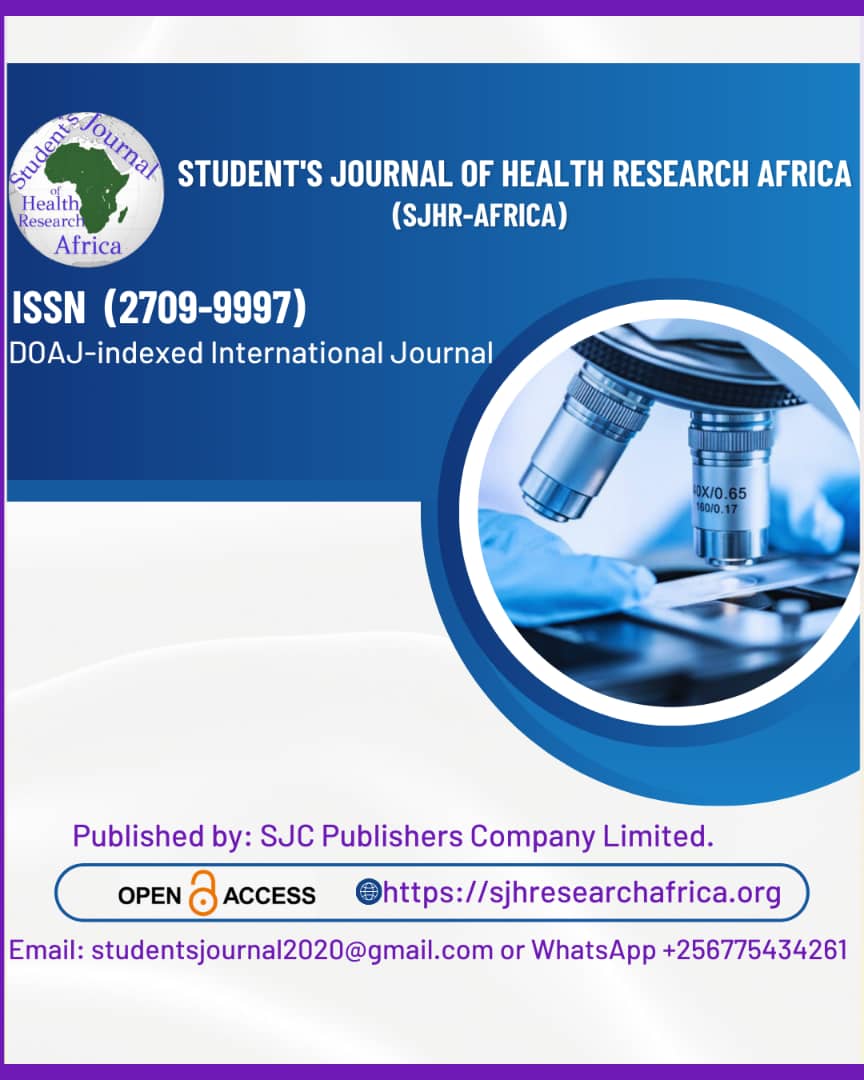IMPROVING ADHERENCE TO METHADONE TREATMENT AMONG YOUNG ADULTS AGED 20-35 YEARS RECEIVING CARE AT BUTABIKA MEDICALLY ASSISTED TREATMENT CLINIC.
DOI:
https://doi.org/10.51168/sjhrafrica.v6i6.1608Keywords:
Methadone Adherence, Psychosocial Support, Mobile Dispensing, Contingency Management, Butabika MAT Clinic, Opioid Use Disorder, Change ManagementAbstract
Background
Adherence to Methadone Maintenance Treatment (MMT) is a critical determinant in managing opioid use disorders. Despite MMT’s proven efficacy, suboptimal adherence rates, particularly in Uganda, impeded its effectiveness. At Butabika Medically Assisted Treatment (MAT) Clinic, only 45% of patients adhered to methadone, highlighting the need for targeted interventions.
Methodology
A quality improvement project was conducted among 378 patients aged 20–35 at Butabika MAT Clinic. Interventions included group and individual psychosocial therapy, patient-led group sessions, psychoeducation, contingency management (token rewards), and mobile methadone dispensing. The Logical Framework Approach, Root Cause Analysis, PESTELI, SWOT, and 7S models guided the project. Monitoring and evaluation were conducted monthly and quarterly, respectively.
Results
The introduction of peer-led group therapy improved engagement and reduced monotony. Contingency management, such as reward tokens and meal provision, incentivized daily attendance. Mobile van dispensing reduced missed doses by addressing logistical barriers. Humanistic, psychodynamic, and behavioral counseling approaches facilitated psychological recovery and treatment adherence. Leadership strategies, including transformational and task-oriented styles, positively influenced service delivery and patient engagement.
Conclusions
Psychosocial interventions, logistical support through mobile units, and contingency-based motivational strategies significantly enhanced adherence to methadone treatment among young adults. Change management frameworks such as Lewin's and Kotter’s models facilitated the implementation and sustainability of new practices.
Recommendations
MAT programs should integrate individualized psychosocial treatment plans, scale contingency management, and expand mobile dispensing services. Staff training and leadership development are crucial to sustaining adherence improvements.
References
Aditya, R. S., Kurniasari, F., Yusuf, A., & Suwito, J. (2017). Experience of the health workers in conducting methadone rehabilitation therapy at the public health center. Dama International Journal of Researchers (DIJR), 2(2), 107–113.
Amato, L., Davoli, M., Perucci, C. A., Ferri, M., Faggiano, F., et al. (2005). An overview of systematic reviews of the effectiveness of opiate maintenance therapies: Available evidence to inform clinical practice and research. Journal of Substance Abuse Treatment, 28(4), 321–329. https://doi.org/10.1016/j.jsat.2005.02.007
Bart, G. (2012). Maintenance medication for opiate addiction: The foundation of recovery. Journal of Addictive Diseases, 31(3), 207–225. https://doi.org/10.1080/10550887.2012.694598
Brown, M. T., & Bussell, J. K. (2011). Medication adherence: Who cares? Mayo Clinic Proceedings, 86(4), 304–314. https://doi.org/10.4065/mcp.2010.0575
Chaisson, R. E., Barnes, G. L., Hackman, J., Watkinson, L., Metha, S., Cavalcante, S., & Moore, R. D. (2001). A randomized, controlled trial of interventions to improve adherence to isoniazid therapy to prevent tuberculosis in injection drug users. The American Journal of Medicine, 110(8), 610–615. https://doi.org/10.1016/S0002-9343(01)00707-2
Clarence, L. (2012). Adherence rates in substance use treatment in the UK: A systematic review [Unpublished manuscript].
Frandsen, B. (2014). Nursing leadership management & leadership styles. AANAC.
Gowing, L., Farrell, M., Bornemann, R., Sullivan, L. E., & Ali, R. (2008). Substitution treatment of injecting opioid users for the prevention of HIV infection. Cochrane Database of Systematic Reviews, (2). https://doi.org/10.1002/14651858.CD004145.pub3
Horne, R., Weinman, J., Barber, N., Elliott, R., & Morgan, M. (2005). Concordance, adherence, and compliance in medicine-taking. National Co-ordinating Centre for NHS Service Delivery and Organisation.
Kelly, S. M., O'Grady, K. E., Brown, B. S., Mitchell, S. G., & Schwartz, R. P. (2001). Predictors of nonadherence to HIV-related medication regimens during methadone stabilization. American Journal on Addictions, 10(1), 69–78. https://doi.org/10.1080/105504901750160472
Khantzian, E. J. (1986). The self-medication hypothesis of addictive disorders: Focus on heroin and cocaine dependence. The American Journal of Psychiatry, 142(11), 1259–1264.
Leiva, R. A., et al. (2014). Improving treatment adherence in patients with chronic diseases: A cluster randomized trial. BMC Family Practice, 15, 142. https://doi.org/10.1186/1471-2296-15-142
Lucas, G. M., Weidle, P. J., Hader, S., & Moore, R. D. (2007). Directly administered antiretroviral therapy in methadone clinics is associated with improved HIV treatment outcomes. Clinical Infectious Diseases, 45(6), 770–776. https://doi.org/10.1086/521263
Navidian, A., et al. (2016). The effectiveness of psycho-educational group training on treatment adherence of patients under methadone maintenance therapy. Journal of Substance Use, 21(6), 631–636. https://doi.org/10.3109/14659891.2015.1130180
Noori, R., & Ahmadipour, H. (2014). Comparison of quality of life and mental health in methadone maintenance treatment clients with and without relapse. International Journal of High Risk Behaviors & Addiction, 3(4), e20959. https://doi.org/10.5812/ijhrba.20959
Parpouchi, M., et al. (2017). Factors associated with adherence to methadone maintenance treatment in a community setting in British Columbia, Canada. Substance Abuse Treatment, Prevention, and Policy, 12(1), 3. https://doi.org/10.1186/s13011-016-0085-4
Protopopescu, C., et al. (2009). Factors associated with non-adherence to methadone maintenance treatment in opioid-dependent patients: A longitudinal study. European Addiction Research, 15(3), 141–149. https://doi.org/10.1159/000213960
Reist, C. (2010). Evidence-based practice: Methadone maintenance therapy. Substance Use & Misuse, 45(3), 308–312. https://doi.org/10.3109/10826080903012671
Roux, P., et al. (2014). Buprenorphine versus methadone maintenance therapy: Outcomes in HIV-infected opioid users treated in a French cohort. Clinical Infectious Diseases, 58(5), 684–691. https://doi.org/10.1093/cid/cit758
Sabate, E. (2001). Adherence to long-term therapies: Evidence for action. World Health Organization.
Sanders, M. R., et al. (2013). Adherence and retention in methadone maintenance therapy. Journal of Substance Abuse Treatment, 44(3), 306–312. https://doi.org/10.1016/j.jsat.2012.08.010
Sharma, M., Chamroonswasdi, K., & Srisorrachatr, S. (2016). Predictors of methadone maintenance therapy adherence among people who inject drugs in Thailand. Journal of Substance Use, 21(2), 157–163. https://doi.org/10.3109/14659891.2015.1018971
Shen, H. W., et al. (2016). The association of methadone dose and treatment adherence in MMT programs in China. Addictive Behaviors, 53, 83–88. https://doi.org/10.1016/j.addbeh.2015.10.008
Thomas, R. J., et al. (2014). Medication adherence: A review of the literature and implications for clinical practice. The Journal for Nurse Practitioners, 10(10), 660–666. https://doi.org/10.1016/j.nurpra.2014.08.017
Tran, B. X., et al. (2018). Impact of methadone maintenance on health-related quality of life in Vietnamese patients with opioid dependence. Substance Abuse Treatment, Prevention, and Policy, 13(1), 19. https://doi.org/10.1186/s13011-018-0156-8
Virshup, B. B. (1985). Art therapy with adolescent drug abusers. American Journal of Art Therapy, 23, 101–108.
Ward, J., Hall, W., & Mattick, R. P. (1994). Methadone maintenance treatment and other opioid replacement therapies. Harwood Academic Publishers.
World Health Organization (WHO). (2001). Adherence to long-term therapies: Policy for action. WHO Press.
Zhou, K., Li, H., Wei, X., Li, T., & Zhuang, G. (2017). The effect of interventions on MMT program adherence and retention. International Journal of Drug Policy, 48, 104–110. https://doi.org/10.1016/j.drugpo.2017.06.003
Downloads
Published
How to Cite
Issue
Section
License
Copyright (c) 2025 Samuel Tumusiime , Jane Frank Nalubega, Edith Akankwasa, Elizabeth Okello, David Kavuma

This work is licensed under a Creative Commons Attribution-NonCommercial-NoDerivatives 4.0 International License.






















